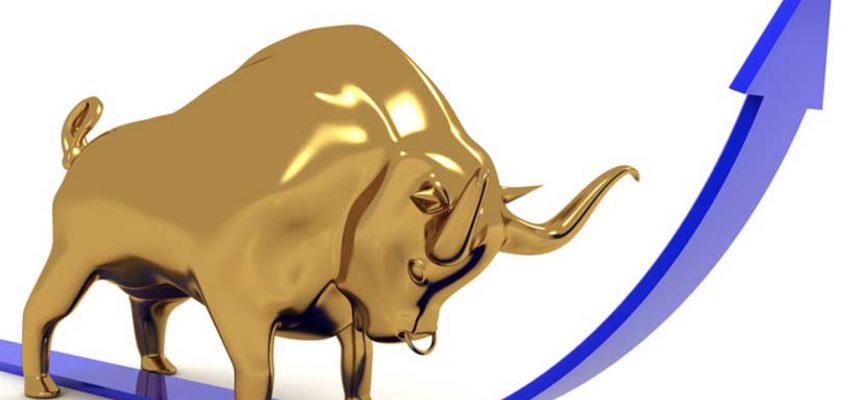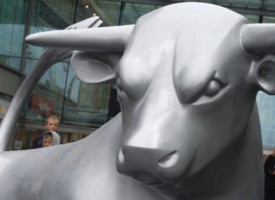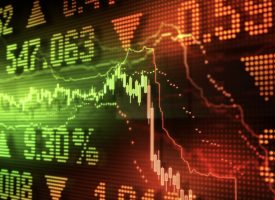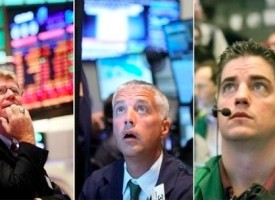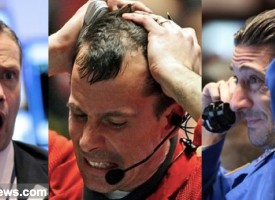Today a legend who is connected in China at the highest levels warned the big risk for America is that China dumps its US dollar holdings. He also said investors should buy gold.
A Deal With The Chinese
By John Ing, Maison Placements
May 1 (King World News) – Tariffs have upset world markets and decades of America-made supply chains helping cause in December the worst single month market sell-off since the Great Depression. Because Mr. Trump views the stock market as the one signifier of the US economy and a simplistic proxy for measuring the success of his policies, this deal-making president regularly sidelined his negotiating team, believing that he could do better.
Now, “Tariff Man” Trump wants a deal with the Chinese because pressure for a deal has escalated daily with both sides ready to settle for a truce. His politically important farming base pushed the president to work out an agreement since the tit for tat countermeasures hurt growth at a time when Donald Trump most needs a trade pact. Total US exports of soybeans fell 28 percent in March compared to a year ago. Although signing USMCA over a year ago, his tariffs on US steel and aluminum remain, hurting US businesses and consumers alike. Moreover, Congress has yet to ratify the trade pact with the Canadian and Mexican legislatures threatening to balk at ratifying the agreement. These deals reflect not how easy is Trump’s new order, but how difficult. Trade deals aren’t that easy to win, it seems.
In fact, the president’s obsession on balanced trade between China and the US was doomed to fail because of America’s huge service sector surplus with China. Yet it’s Germany, not China that has the world’s largest external account surplus. And still, not content with a “victorious” truce, the president is to focus next on Europe, threatening to impose steel tariffs on foreign cars. Europe countered with $11 billion of tariffs … and the beat goes on.
Symbiotic Relationship
To be sure the recent US – China tensions have escalated beyond trade and some believe that the war is really over technological supremacy. Our view is that while there is the appearance of two trading superpowers vying for advantage, the US is most reliant on China whilst China is reliant on the US. This quid-pro-quo arrangement stems from China’s need for American markets for its goods and in turn, the US need for outside funding…
ALERT:
Mining legend Ross Beaty (Chairman Pan American Silver) is investing in a company very few people know about. To find out which company CLICK HERE OR ON THE IMAGE BELOW.
 Sponsored
Sponsored
Unlike Japan or China which finance their deficits internally, the US is dependent on foreign offshore funds for up to a third of their deficits. On the other hand, China’s generated surpluses are recycled in US treasuries and lately, gold. China today has $3.1 trillion of foreign exchange reserves, the largest in the world and has been diversifying its reliance on the dollar, seeking to internationalize the renminbi as a reserve currency. Currently five percent of foreign global reserves are in renminbi, in contrast to almost 60 percent in dollars. Thus over the short term, despite attempts to internationalize the renminbi, both countries need each other in a symbiotic relationship.
America’s Growing Isolation
Of concern is that in designing a new world order, America’s diplomatic isolation creates vacuums that their rivals fill. For example, Trump’s call for regime change in Venezuela was rejected by Russia who subsequently sent troops to protect the oil rich socialist nation and soon after, China sent soldiers on a “humanitarian mission” to one of Venezuela’s military bases. And in an effort to put pressure on Cuba for their support of Venezuela, the US opened a can of worms by reactivating the Helms-Burton Act which was waived by every president over the past 25 years. The international community had vehemently opposed the move because the act exposes European and Canadian businesses to American lawsuits.
And, in yet another move that escalated tensions with China, Trump’s unilateral decision to withdraw from the Iran nuclear deal not only isolated Washington, but the ending of the sanction waivers to any country importing Iranian crude, pits the US against allies, India, Turkey, Japan and South Korea. The policy move further undercuts America’s relationships, deepening Washington’s sense of isolation and in focusing on Iran and Venezuela, caused a spike in oil prices, lighting a fuse to the geopolitical sensitive Middle East. Only a month ago, Trump tweeted, “the world cannot afford an oil price hike-fragile”… as is his policy.
America also criticized Italy for joining China’s Belt and Road Plan (BRI). Beijing’s global Belt Road Initiative aims to finance and build roads, ports and railways linking more than 80 countries including Eurasia, the Middle East and Africa. Italy is to be the first G7 country joining six EU countries to endorse the BRI despite pressure from Washington. America has weaponized this participation as a “them versus us” argument as part of the China vs US conflict.
But that may not matter, the US is playing catch up, particularly in technology where China has more internet users, generates more data and is at the forefront in 5G. Their tech sector is already ahead in batteries and chips and artificial intelligence is next. Similarly, in less than a decade, China’s carmakers today make more cars than the US, with some 325 million cars on its roads…
BONUS INTERVIEW:
To listen to billionaire Eric Sprott discuss his prediction for skyrocketing silver
as well as his top silver pick CLICK HERE OR BELOW:
America’s Fiscal Indiscipline is its Achilles Heel
No doubt once the two superpowers wrap up their trade truce, global markets will rally. However, looking ahead, a trade deal is not the panacea for the market. We believe that this presents a “sell on news” opportunity as the market must then cope with a stagflation US economy, overvalued valuations plus the long term impact of trade wars, a Brexit and a subsequent legacy of debt, deficits and doom.
The deeper point, is that the US trade deficit last year hit a 10-year high of $621 billion and despite the imposition of Trump’s tariffs, the deficit rose 12.5 percent last year with a 6.3 percent expansion in US exports, but a whopping 7.5 percent boost in imports. With the trade numbers improving lately to eight month lows, the US economy Q1 GDP at 3.2 percent beat expectations. However drilling down this was due more to a boost in inventories which offset an ominous drop in household spending. In fact, recent studies show that the cost of his tariff war has been borne by American consumers who have paid more in higher prices, than the revenues that the tariffs were supposed to generate.
While, America’s debt and deficits must be financed for years to come, inflation has been a no show despite corporate debt soaring to record highs, exceeding pre-crisis levels. Faced with chronic low interest rates, junk bonds too have reached the same size of subprime mortgage debt which exacerbated the financial crisis of 2007. Low bond yields have already done severe damage to global pension systems, altering the risk profile of assets making leveraged bets potential time bombs. Bond sales boomed as the Fed’s pivot prompted a fresh binge in borrowing. This boom has not yet gone bust.
Abandoning Monetary Orthodoxy
While lawmakers talk about the need to tackle trade, the elephant in the room is spending and the resulting deficits. Both Democrats and Republicans, it seems have given up on curbing deficits. They are reluctant to cut spending in spite of the longest government shutdown in history. Instead they have come up with new and improved money printing ways to pay for their bills. The Democrats are pushing a new-old theorem, Modern Monetary Theory (MMT) aka unlimited money printing, to finance new spending programs such as the Green New Deal or Medicare for all. The Democrats’ belief is rooted in a half century old phenomenon that government can always borrow in their own currency because they could easily create more money. That spending falls in the same category as that other unconventional tool, “quantitative easing” (QE) whose roots stem from former Fed Chairman Ben Bernanke’s description of “helicopter money”, which left a legacy of debt, deficit and doom. Both QE and helicopter money involves the printing of money to expand money supply, however by contrast, helicopter money shoveled money into the system, without increasing the Fed’s balance sheet.
Economic orthodoxy wisdom suggests that large doses of government debt will eventually lead to higher inflation and interest rates.
The Republicans and Donald Trump have pushed for an easier monetary policy calling for trillion dollar deficits and yet another dose of bond buying stimulus. Ironically, the Republicans’ instincts are rooted in the early seventies, when once dormant inflation returned from the dead resurrected by a potent mixture of low interest rates, the Vietnam War and the pumping of liquidity into the economy. Today we again have record low interest rates, the pumping of trillions, not billions of liquidity into the financial system and moribund inflation. However, while Main Street has yet to experience higher core inflation, Wall Street has seen an unprecedented virulent asset inflation, fueled by a series of record highs, unicorn IPOs, billion dollar buybacks and record leverage. The Republicans are set to even outspend the Democrats. The swamp of Washington still needs to be drained. In abandoning monetary orthodoxy, the seeds of inflation have been sown and that should be of concern to investors.
And worse, as part of today’s voodoo economics, Mr. Trump “has doubled down”, pushing the Fed to pursue “Quantitative Easing IV”, calling for even lower rates despite the Fed’s unexpected U-turn in monetary policy to keep rates low. And after shaking up Homeland Security in a crackdown on immigration, he set his sights on shaking up the independent Fed by filling two vacancies on the Fed’s powerful board, with political allies. For the last half century, central banks were the last line of fiscal defense, curbing economic booms and busts. Ironically the president’s blatant attempt to pressure the Fed is not dissimilar to other countries where the central banks of India, Venezuela, Turkey and Argentina have also been pressured to loosen monetary policies.
It Has Happened Before
Once before, facing re-election, President Nixon pressured Fed Chairman Arthur Burns to slash rates which boosted Nixon’s re-election chances in 1972. Back then, runaway double digit inflation ensued, and the consequence was near hyperinflation and a crash. Nixon resigned, but left to clean up the mess was Fed Chair Paul Volcker who slapped on double digit interest rates to stamp out inflation. A deep recession, of course followed. While attempts to influence central bankers is nothing new, history shows that once the credibility and independence is lost, the inflationary consequences becomes evident, first in risk assets and then spreads…
BONUS INTERVIEW:
To listen to Doug Casey’s just-released KWN interview discussing his prediction of financial and economic chaos and a panic into gold CLICK HERE OR BELOW:
At center stage is the US dollar. For over half a century the US government has enjoyed the “preeminent privilege” of being allowed to print and borrow in their own currency, thanks to its role as the primary world’s reserve currency. America could not default because they could always print new money to pay their creditors. That privilege, once enjoyed by Great Britain was lost in the Forties, when Britain’s debts exceeded their ability to pay. The United States, like Britain before has taken that privilege for granted.
We believe America’s fiscal irresponsibility jeopardizes that status. President Trump has called a halt to the unwinding and normalization of the Fed’s balance sheet which is choking already from the legacy of monetizing three rounds of bond buying. He also threatened to replace his handpicked Fed Chairman, Jerome Powell, drawing a critical fault line through the Fed’s independence. The consequences for the dollar are far reaching. In shaking up the Fed and pushing for a looser policy, Trump and his team’s ignorance of the inexorable rise in debt compromises the very foundation of the world’s reserve currency. Déjà vu?
Against this backdrop, America’s public debt has now ratcheted up to a record $22 trillion, boosted by the unfunded tax cut which increased 18 percent in spending, violating the spending cap. The Fed’s balance sheet at $4 trillion is weighed down with excessive exposure to government debt which is a potential systemic problem, in contrast to only $1 trillion in 2008. That other large structural deficit continues to grow as Trump unleashed a $4.75 trillion budget which won’t get Congressional approval. Trump’s spending plans call for a debt to GDP of 100 percent plus this year and the interest payments alone to service that debt, exceeds $500 billion or more than the US spends on defense spending. And despite the decline of America’s credit rating in 2011, and a decade after the financial crisis, US public debt remains at double A (S&P). And now, Mr. Trump and his administration is set to push the US into the deepest deficits on record.
America’s Financial Hegemony Is Not Sustainable
To be sure after a decade of record stock market gains and IPO unicorns, the world’s central banks should be threatening to pull the punch bowl away. However the December market collapse was the worst on record as the stock market vigilantes took matters into their own hands, causing the Fed and other central banks to execute a U-turn, putting interest rates on hold which drove markets again to new record levels. However, if December was anything, it was a wake-up call. For too long the United States have mismanaged its finances, consuming more than they are producing. We also believe that America’s established control over global finance and weaponization of sanctions threatens America’s central role in world’s financial markets.
With more than $10 trillion of bonds showing negative yields, fears of deflation are growing. Like the Thirties, investors are paying also for the privilege to park their money and if held to redemption, would lose money. Noteworthy was during the Dirty Thirties, gold was a hedge against deflation, acting as a store of value, whilst asset prices plummeted in a deflationary spiral.
We believe that the Trump-inspired trade wars, an unpredictable presidency together with the weaponization of American financial hegemony has in large part forced investors to look for alternatives. The dollar’s global role gives America the means to impose financial sanctions to great effect. It can exclude countries from the dollar based international payments system. Trump’s populist approach whilst thumbing his nose at foreign investors has resulted in a weakening view of the US dollar. Although there are few alternatives, America’s financial hegemony is simply not sustainable. Gold is a hedge against that.
The US is not dissimilar to an emerging market economy where their balance of payments is as terrible as their fiscal debt. Today, the greenback has run into resistance on fears of a protracted trade war and an inverted yield curve. Geopolitics is playing a greater part here. As the global repercussion spreads, America depends on the very countries that it labels a security risk to finance their consumption – how naïve and dangerous.
On that point, our view is that the Fed has reached the limits of its abilities with a balance sheet which represents more than 25 percent of US GDP. With one third of America’s debt financed by outsiders, an inverted yield curve has encouraged investors to look elsewhere. We believe that the US financial hegemony and deteriorating financial status has jeopardized the dollar’s reserve status and we are near that point of inflection where like Great Britain before, creditors will balk at financing US obligations…
Gold is making its way back into the global monetary
system, to learn more CLICK HERE!
 Sponsored
Sponsored
Gold Has Become Money Again
Fittingly, gold is an alternative to the dollar. In the past, it has been a protector or hedge against the debasement of currency, because it is less susceptible to government manipulation. Last year, central banks purchased a near record 23 million ounces, becoming the world’s largest buyer, adding to their reserves at the highest pace in 50 years. Central banks keep dollars in reserve but under the new Basel III standard, gold has taken on more importance and can be today valued the same as dollars. Basel III returns gold as a meaningful reserve asset whereby, gold is now risk weighted as a Tier I asset as part of total reserves. Thus, gold reserves held on central banks’ balance sheet can be valued at 100 percent allowing them to increase their liquidity and revalue their balance sheets upward. Gold has become money again.
In total, governments added 652 tonnes in 2018, the second highest total on record, according to the World Gold Council. They see gold as an alternative to the dollar. China has been on a gold buying spree, recently purchasing gold again for the past four months, laying a foundation of gold in their $3.1 trillion reserve stockpile. China is the world’s largest consumer of gold and must import gold to satisfy domestic demands. China is also the world’s largest creditor and their gold holdings make them less dependent on the dollar, particularly since the United States has weaponized the dollar. Other countries are diversifying with Saudi Arabia considering dropping the petrodollar and even threatening to dump their stockpile of treasuries should Congress lift sovereign immunity from US antitrust laws (NOPEC). Russia has already replaced the dollar with gold, dumping all their US debt, purchasing one third of the world’s gold supplies last year. They have tripled their reserves over the past decade as a counter to the US dollar dominance and hold 2,163 tonnes of gold.
Russia and China have become the fifth and sixth largest gold holders in the world, rivaling America which has the largest stockpile at 8,000 tonnes. The risk for America is that China also dumps its dollar holdings which would create problems for the US government’s financing plans, and the dollar itself. Remember the Golden Rule: “Whoever has the gold makes the rules.”
We believe that investors remain too complacent, unwilling and unable to fathom the magnitude of the problem. The unsustainable is no longer sustainable. We also believe that when “informed insiders” such as the world’s central banks buy gold at the highest pace in fifty years and the gold miners buy each other, that gold must be a screaming buy. Compared with stocks and other financial assets, gold is inexpensive. Gold is like Marie Kondo, the neat freak. However, unlike the decluttering guru, gold’s real joy is its traditional store of value. It is a good thing to have.
KWN has now released the powerful and timely audio interview with Andrew Maguire and you can listen to it by CLICKING HERE OR ON THE IMAGE BELOW.
***Also just released: Multi-Billionaire Hugo Salinas Price – Raymond James Says Gold Stocks May Finally Be A Buy Here CLICK HERE TO READ.
© 2019 by King World News®. All Rights Reserved. This material may not be published, broadcast, rewritten, or redistributed. However, linking directly to the articles is permitted and encouraged.

